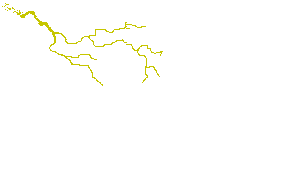
Bob Coutts
 |
 |
 |
 |
 |

Tornado |
TORNADOS:
A tornado is a large, vertical, whirling air mass hundreds of meters across. Wind speeds in a tornado can go well over a hundred kilometers an hour with spikes up to 300 kph !!. These highly destructive whirlwinds are created when cooler upper level air masses have much different air pressure than the air at ground level. If an unusual condition exists in which a warm air mass is inserted underneath a cold air mass, the warm air wants to rise. As it rises, it whirls on it's way up through the intermediate level air, whirling as it rises much like an up-side down drain in a sink. The power in this whirling air mass is so big that whole neighborhoods full of houses can be destroyed in minutes and the wreckage blown up into the sky along with everything in them!.
|

Hurricane |
HURRICANES:
Hurricanes
are extremely large, flat whirling air masses, usually hundreds of kilometers
across. Many hurricanes are bigger than
|

Lightning |
LIGHTNING:
Lightning is the discharge of extremely large amounts of static electricity between clouds and the ground. The voltages for these enormous sparks can reach several million volts !!! If a lightning bolt hits a tree, the thermal energy released into the tree can cause the sap in the tree to turn into high pressure steam and the tree literally explodes. Lightning rods connected to heavy cables are mounted on top of tall buildings in lightning country, to provide a safe path for the electricity to discharge to ground. If the lightning discharges through the building, the heat from the current flow could cause the building to burn.
|

Clouds |
CLOUDS:
Clouds
are
made when water molecules in warm, humid air slow down as the
air is cooled. When the molecules slow down and stick together, they
form micro drops. As these micro drops cool even further as they rise higher
into the cooler atmosphere, they congeal, forming water droplets
large enough to reflect light. These droplets make up bright white clouds
like the ones in the picture on the left. If the cooling process
continues, then the congealing droplets get even larger. The bigger
droplets absorb light, making the cloud darker, as toward the bottom of
the picture. When the droplets get very large, the air can no longer hold
them up and they fall, making rain. If an up-draft ( an upward wind ) pushes
them up further in the atmosphere, the drops can get very large and fall
once again. If the temperature gets cold enough in the upper atmosphere,
they can freeze, making hail.
|

